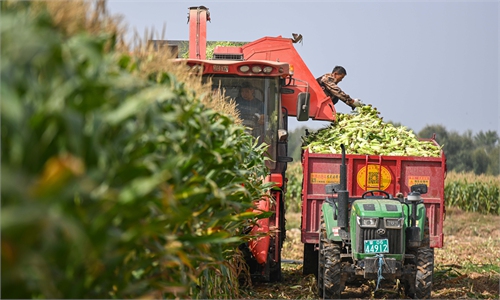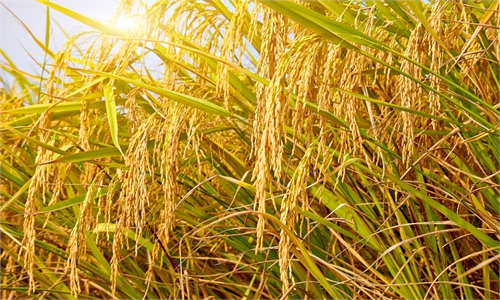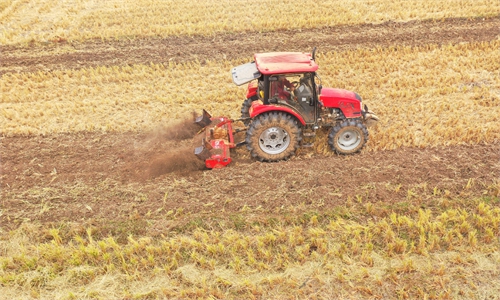IN-DEPTH / IN-DEPTH
GT on the spot: How China can achieve strategic soybean security in an increasingly complex geopolitical environment
Unleashed potential
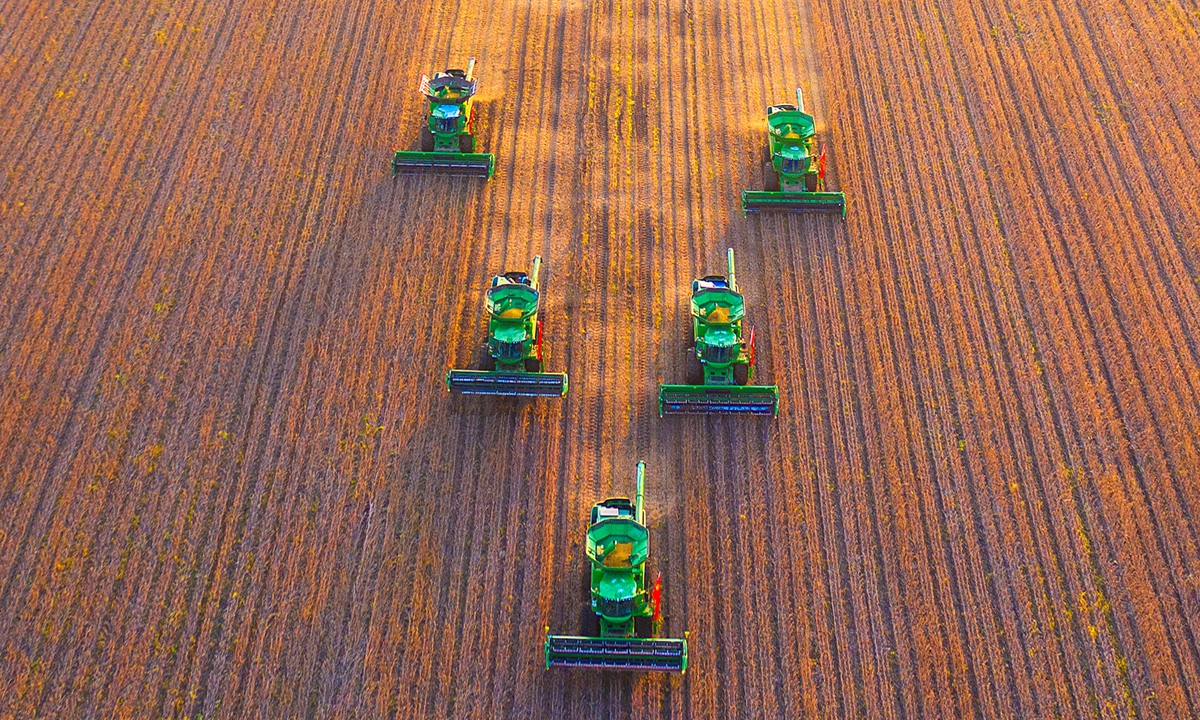
Combined harvesters work in tandem locomotives in a soybean field in Heihe, Heilongjiang Province, on Septembre 30, 2020. Photo: VCG
Soybeans, accounting for the highest proportion of China's food imports, were mentioned eight times in China's No.1 central document of 2023 issued on February 13, more than any other food crop that is mentioned.Meanwhile, in this key policy document released by the central government, new expectations were outlined for soybeans, as well as for China's vast northeastern region, the country's main soybean-producing area.
Recently, the Global Times reporters visited Heihe city in Northeast China's Heilongjiang Province.Heihe is the largest soybean cultivation region among all the prefecture-level cities in China.
The reporters investigated how China can achieve strategic soybean security in an increasingly complex geopolitical environment.
Important production region
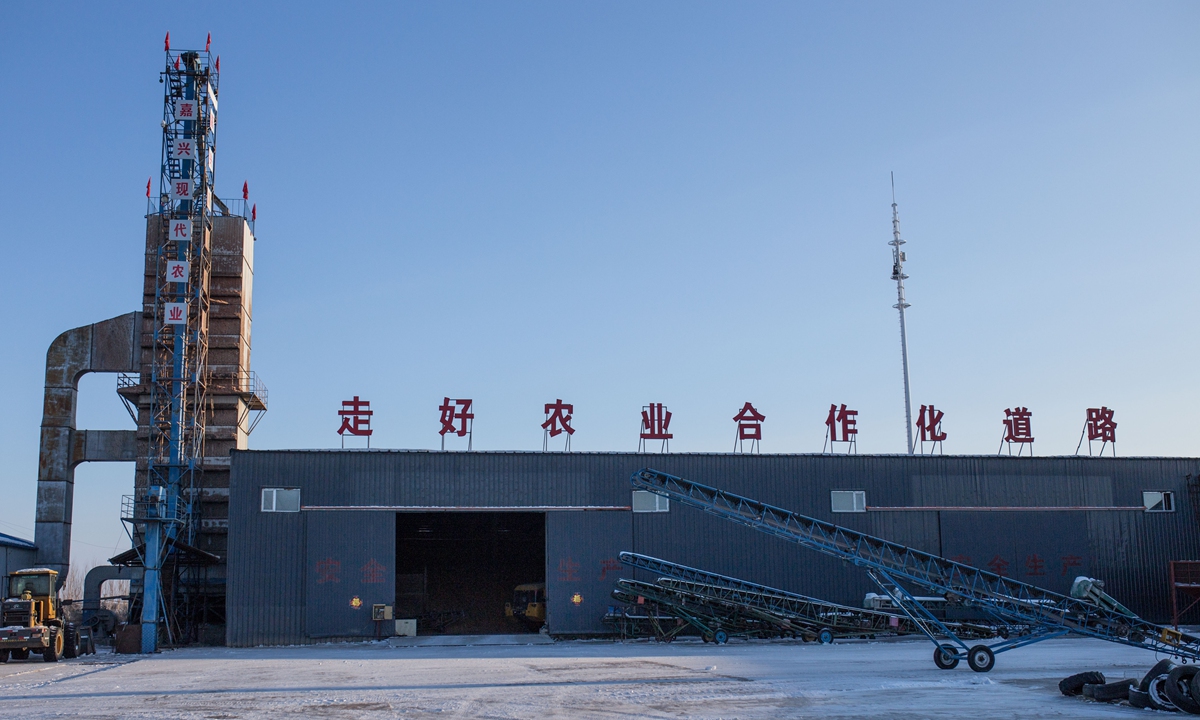
A soybean production factory in Heihe, Northeast China's Heilongjiang Province Photo: Shan Jie/GT
After a 20-minute drive from downtown Heihe, a large welcome sign, set against the backdrop of boundless green bean fields, greets those arriving at the entrance of the Dawusili village.This village is known among the locals as the "hometown of soybeans."
The Jiaxing Cooperative, which is based in Dawusili village, utilizes 25,000 mu (10,117 hectares) of its 35,000 mu of arable land to cultivate soybeans, accounting for 70 percent of total arable land use.
Gai Yonghai, a national agricultural model worker and chairman of the Jiaxing Cooperative, has also increased his own soybean cultivation area from the previous 13,000 mu to 25,000 mu in 2022.
According to data from the General Administration of Customs of China, China imported a total of 146.87 million tons of grains in 2022, the bulk of which consisted of soybeans at an impressive 91.081 million tons. In 2022, China spent a total of $82.6459 billion on imported grain, of which $61.236 billion was spent on soybeans.
In 2022, the international grain market was turbulent as witnessed by the sharp fluctuation in grain prices. Under the circumstances, though China's rations are under no immediate threat, the strategic security of soybeans, which is heavily dependent on overseas markets, has become increasingly prominent.
In 2022, Heilongjiang Province vigorously expanded soybean cultivation. As China's largest soybean producer, the province set new records in 2022 in terms of soybean output and total cultivation area, figures from the National Bureau of Statistics show.
Heilongjiang yielded 9.54 million tons of soybeans this year, up 32.6 percent year-on-year, accounting for 47 percent of the country's total soybean output. The total soybean cultivation area in the province stands at 73.98 million mu, up 26.9 percent year-on-year, according to the Xinhua News Agency.
To ensure national food security, Heilongjiang has strategically increased its soybean yields through a raft of measures such as improving the varieties cultivated and adopting innovative field management techniques.
"Heilongjiang is the most important production area for soybeans in China, while in Heilongjiang, Heihe is the leading city in soybean cultivation," Lu Wencheng, a scientist on soybean cultivation and a researcher with the Heihe Branch of the Heilongjiang Academy of Agricultural Sciences, told the Global Times.
One out of every seven soybean beads harvested in China comes from Heihe.
According to Lu, Heihe owns 28 million mu of extremely fertile "black earth," which is fondly known as the "giant panda" of arable land. The favorable geographical environment aids in the excellent quality of locally cultivated soybeans. For example, isoflavones, vitamin E, carotenoids, and 16 other trace elements normally found in soybeans are higher in Heihe-produced soybeans than the national average.
Che Fuhai, deputy director of the Heihe Grain Bureau, told the Global Times in an interview that Heilongjiang is the "ballast stone" in the country's efforts to maintain it's food security.
According to data provided to the Global Times, the national soybean production in 2022 reached 20 million tons, of which about one-seventh, was contributed by Heihe. In 2022, one-third of the expanded soybean cultivation area in Heilongjiang was in Heihe.
Along with ensuring and expanding the total cultivation area, Lu told the Global Times that ongoing scientific and technological research of the soybean seed has led to continuously improving the quality and efficiency of soybean cultivation and production, which has played an important role in ensuring the safety of the total national soybeans harvest.
Realistic issues
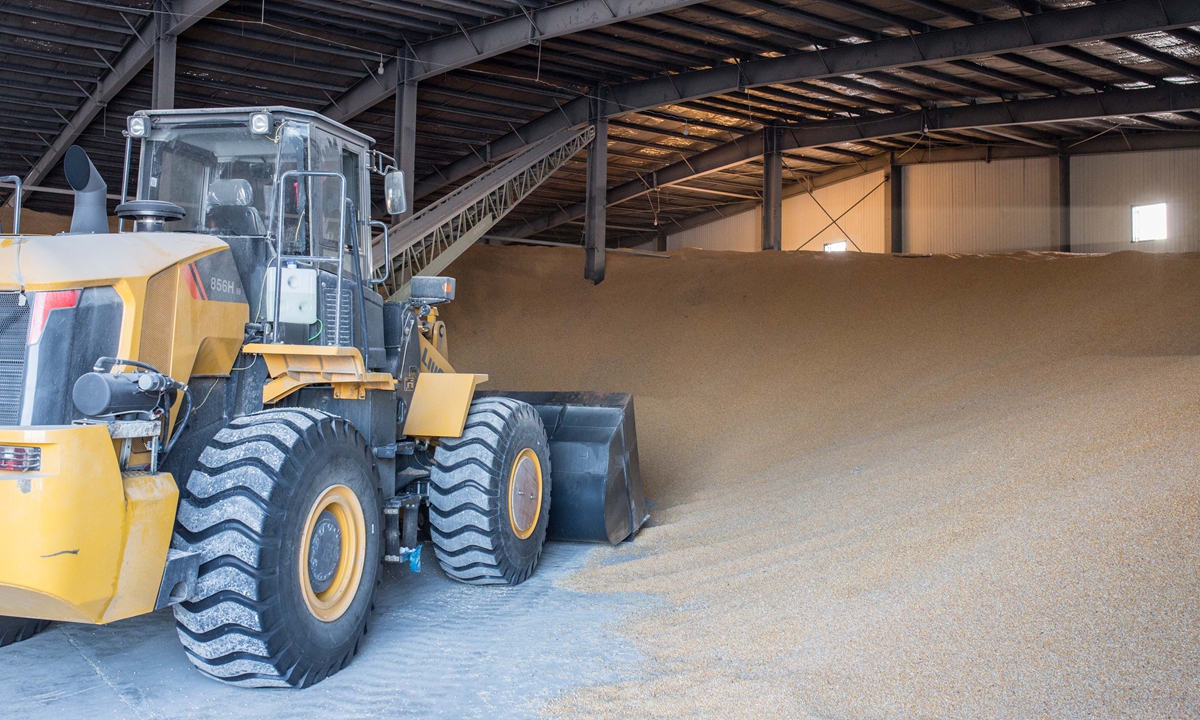
Photo taken on February 11, 2023 shows a soybean storage warehouse in Heihe. Photo: Shan Jie/GT
Due to the huge demand, China relies on overseas producers to ensure the supply security of soybeans, which also directly exposes Heihe soybeans to fierce competition from imported genetically modified (GMO) soybeans.Lu, a soybean specialist said he wants to cultivate better "soybean chips" as soon as possible to increase production, enhance the competitiveness of domestic soybeans, and reduce, if not entirely end, dependence on overseas producers, through utilizing the limited land resources.
As a farmer, Gai not only has to face the pressure of rising cultivation costs, but also has to compete with low-cost but high-yield imports to find a market for locally produced soybeans.
Gai said that foreign soybeans, especially those sourced from the US, are a high-yielding GMO variety, combined with low land costs, and large-scale industrial farming. The price of American soybeans flooding the market through Hong Kong is far lower than the market price of soybeans locally produced in Heilongjiang.
Despite their demonstrably high quality, Heilongjiang's soybeans are obviously at a disadvantage in terms of competitive pricing.
"The quality of soybeans grown in Heilongjiang is suitable for the middle- and high-end market, and should not be used as feed grain like imported soybeans," Gai said.
However, the middle- to high-end market for soybeans is far from being developed in China. Gai expressed his concerns about the sales and prices of soybeans annually.
For Jiaxing Cooperatives, if the government agencies purchase soybeans as they do with wheat and rice, it could alleviate the worries of soybean farmers and boost their enthusiasm to expand the cultivation of soybeans.
In addition, Heihe soybeans face competition from local corn. Gai said that corn has a high yield, a wide range of applications, and is easy to sell. Cooperative farmers tend to grow more corn when prices are good.
Officials from related national authorities have been conducting investigations and surveys in Heihe since the beginning of the year. Gai said he and the farmers in his cooperative hope this year's policies will be implemented sooner rather than later, which will guarantee the soybean cultivation area.
According to Lu, the key to expanding the cultivation of soybean is the efficient provision of quality seeds. In other words, mastering core technologies in soybean seed engineering would positively aid China in ending its high dependence on imported soybeans.
Heihe is making efforts in this regard, including innovating breeding biotechnology and integrating the construction of the Nanfan Silicon Valley in Sanya, South China's Hainan Province.
Nanfan is a process that accelerates the seed breeding process in South China's warmer climate, greatly improving the adaptability of varieties. Hainan is China's largest Nanfan breeding base.
Various efforts
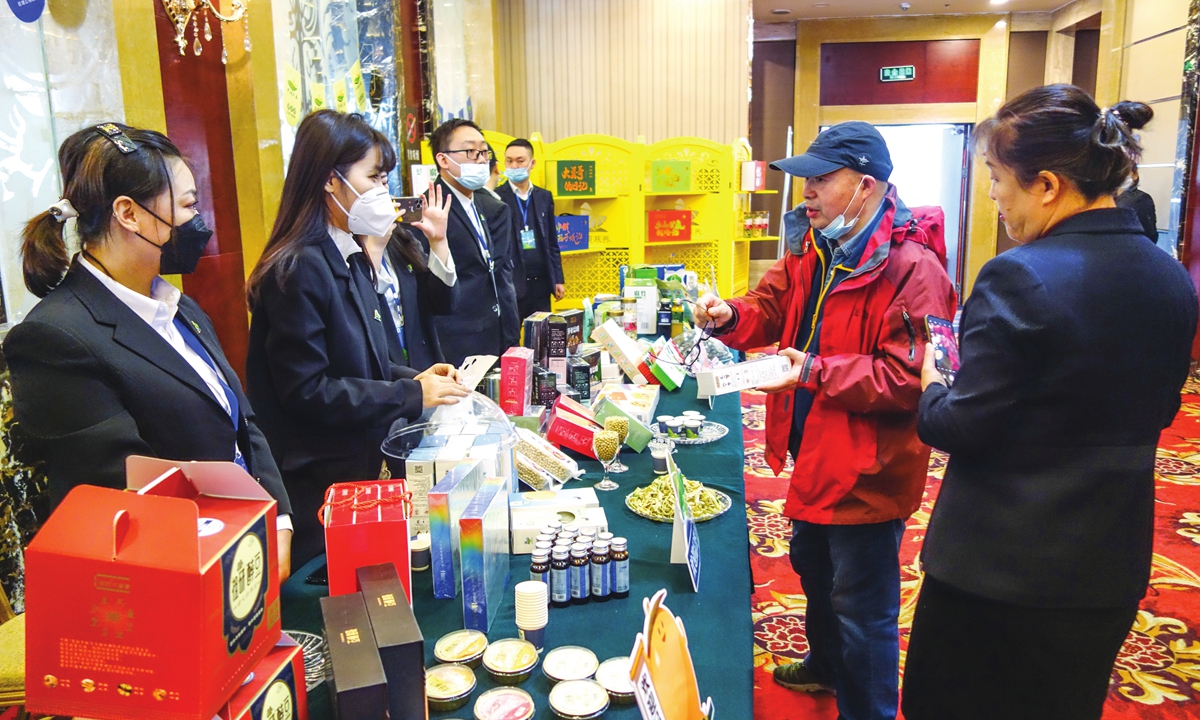
Attendees at the partnership action meeting for transforming scientific and technological achievements of the national soybean industry visit the Heihe soybean products display area in Heihe, Heilongjiang Province, on April 7, 2021. Photo: IC
Gai's cooperative uses organic fertilizer in order to help protect the black earth in Heihe. Heilongjiang's provincial authorities have also set up strict protective and supervisory measures for the black earth.Black earth is the root of China's food security, Che said.
This year's No.1 central document called for the expansion of soybean cultivation.
Gai is happy to see that the document also unveiled supportive policies, including subsidies to farmers and the launch of planting insurance pilot projects.
Lu and his team are also deeply exploring soybean genetic resources to lay the foundation for the development of new varieties of soybeans.
The local Heihe government said at a meeting on February 4 that the city will build a soybean seed base covering more than 260 mu (about 17 hectares).
Honestly, it is impossible for China to get rid of its dependence on imported soybean as the supply market of domestic soybean has a lot of uncertainty, Lu said.
But it is also notable that China has been improving its self-supply capacity and enhancing investment in research and development, he told the Global Times.
There is still a lot of uncertainty in the future given the turbulent international situation, Lu noted.
"As scientists, we would accelerate technological innovation to promote the production and quality of domestic soybean in order to help guarantee the country's food security," he said.
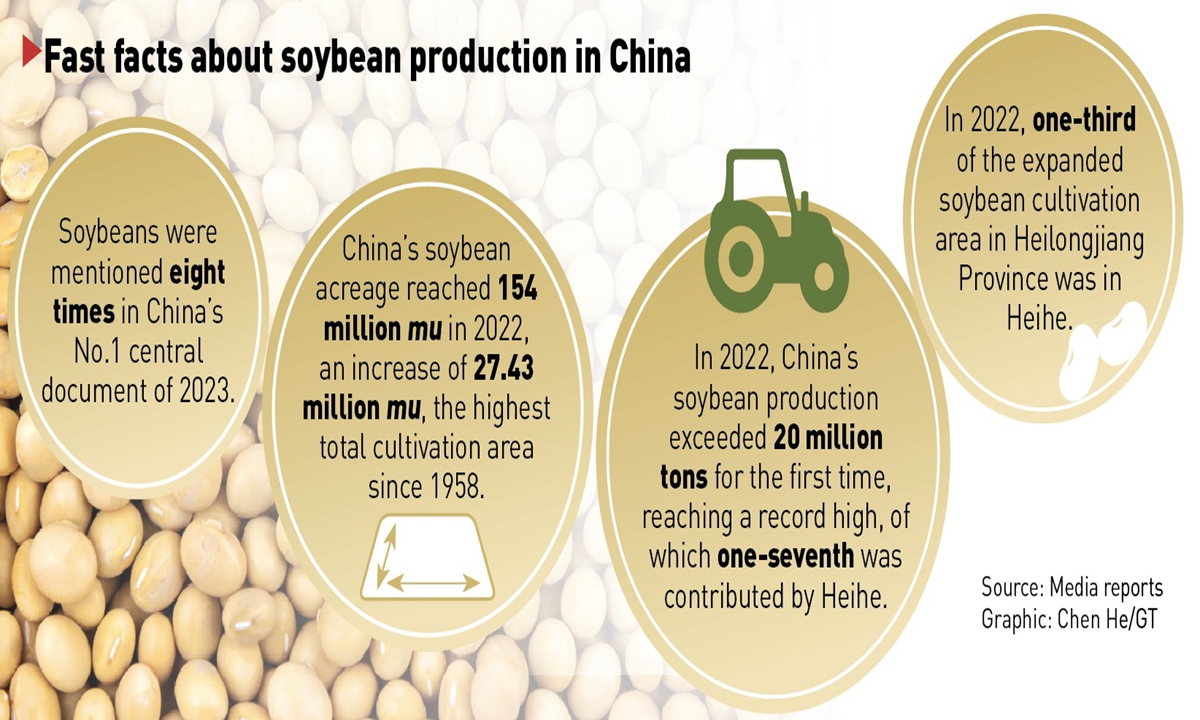
Graphic: GT

